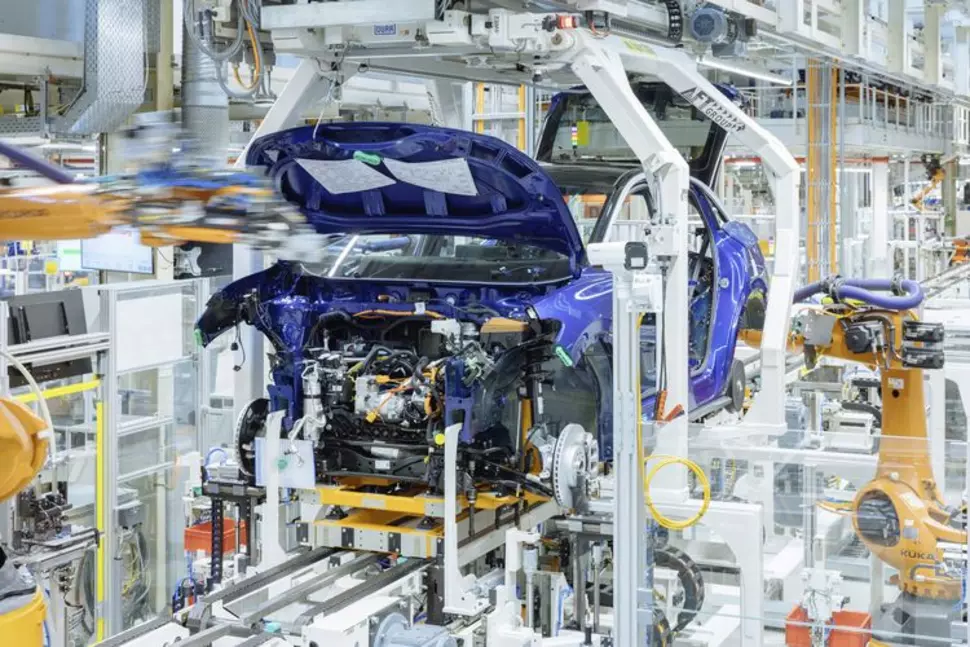Volkswagen in Zwickau, Chemnitz, and Dresden
The VW Group has been involved in Saxony for over 30 years. VW was also relying on the unique expertise of “Autoland Saxony” as part of its electromobility offensive - it started in Zwickau.

Infomodul
Facts about Volkswagen Sachsen
-
May 1990
Start of series production at the Zwickau site -
13,000 employees
in Zwickau, Chemnitz, Dresden -
> 7 million vehicles / 18 million motors
"Made in Saxony" (until 2023) -
1,300 million euros (2019 - 2022)
investment sum for the transformation of the Zwickau plant
About Volkswagen Sachsen GmbH
The founding of Volkswagen Sachsen GmbH in December 1990 marked the start of Volkswagen AG's ambitious project to establish a competitive production facility for Volkswagen vehicles and engines in one of Germany's most traditional automobile manufacturing regions. In addition to the temporary use of existing facilities at the Zwickau and Chemnitz sites, which were completely modernized by Volkswagen, two new production facilities for vehicle and engine construction were built. The Gläserne Manufaktur Dresden was opened in 2001. In 2014, Automobilmanufaktur Dresden GmbH merged with Volkswagen Sachsen GmbH.
Since then, Volkswagen Sachsen GmbH has included the Zwickau vehicle plant, the Chemnitz engine plant and the Gläserne Manufaktur Dresden. Volkswagen Sachsen GmbH employs 11,500 people (including the Volkswagen Training Institute). Around 98 percent of the workforce have completed specialist vocational training or have a master craftsman, university or college degree. The average age is around 45 years and the proportion of women is currently 12.7 percent.
Volkswagen SachsenZwickau vehicle plant
The Zwickau vehicle plant covers an area of 1,800,000 square meters. This is equivalent to the size of 252 soccer pitches.
Only fully electric vehicles such as the Volkswagen ID.3, ID.4 & ID.5, the Audi Q4 e-tron and Sportback e-tron and the Seat Cupra Born are produced in Zwickau. The transformation of the Zwickau plant into an all-electric multi-brand site was completed in January 2022 with the start of production of the ID.5.
The last combustion vehicle rolled off the production line on June 26, 2020 - a historic milestone. Around 204,000 vehicles were produced in 2024. Since the site was founded in 1990, almost seven million vehicles have left the factory halls. Zwickau played a key role in the start of e-vehicle production: for the first time, a large car factory was completely converted to electromobility at a cost of 1.2 billion euros. Six e-models for three Group brands are built in Zwickau. The bodies for the Bentley Bentayga and the Lamborghini Urus are also produced in Zwickau.
Transparent Factory Dresden
With the start of production of the ID.3 in January 2021 at the Gläserne Manufaktur Dresden, the former "Center of Future Mobility" has continuously developed into the "Home of ID." in recent years.
The central goal: as a beacon of the Volkswagen brand in Germany, to offer customers, visitors and guests a holistic experience of the ID. Family - from advice and test drives to modern event formats and the handover of electric vehicles. Another focus of the strategic realignment is the expansion into a research and innovation location, which will drive forward innovative projects in small series for later use at large volume locations in the Volkswagen brand.
Dresden's largest public and partly solar-powered e-mobility station was built directly at the Gläserne Manufaktur. It has been in operation since April 2017. A cooperation was also agreed between Volkswagen Saxony and the state capital of Dresden. The aim is to develop Dresden into a model city for electromobility and digitalization.
Gläserne Manufaktur DresdenChemnitz engine plant
The total area of the engine plant in Chemnitz is 213,000 square meters. This corresponds to an area the size of 30 soccer pitches. It is located directly next to the Chemnitz city park. With around 1,800 employees (including dual students and trainees), Volkswagen in Chemnitz is one of the largest private employers in the city.
The Chemnitz engine plant supplies engines to the vehicle plants and components to the Volkswagen Group's component plants. The production portfolio includes modern and economical turbocharged direct-injection petrol engines (TSI engines) as well as engine assemblies such as balancer shafts and integrated valve train modules. Within the Group, Chemnitz is the type leader for EA 211 engines (1.0 liter and 1.5 liter displacement). Each start-up of the three engines at other Group locations worldwide is supported by experts from the Chemnitz plant. More than 20 million Volkswagen engines have been produced at the Chemnitz plant since 1988. The production figure for 2024 was around 720,000 engines.
In the future, the site will also enter into the production of components for e-mobility. Thermal management has already been confirmed as the first product.
Volkswagen Training Institute, Zwickau
The Volkswagen Training Institute in Zwickau was founded on December 14, 1990 as an associated company of Volkswagen AG. Since January 1, 2013, the institute has been a wholly owned subsidiary of Volkswagen Sachsen GmbH. Today, 126 employees work here.
Since 1990, the Volkswagen Training Institute has been active at three locations in Saxony (Zwickau, Chemnitz, Crossen) for customers from various industries in the fields of vocational qualification, personnel development and organizational consulting. This includes in particular the implementation of practical vocational training, the implementation of further training measures and the provision of personnel development and organizational consulting services.
Volkswagen Bildungsinstitut